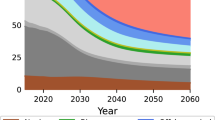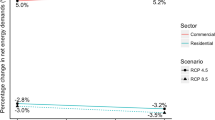Abstract
Future scenarios of the energy system under greenhouse gas emission constraints depict dramatic growth in a range of energy technologies. Technological growth dynamics observed historically provide a useful comparator for these future trajectories. We find that historical time series data reveal a consistent relationship between how much a technology’s cumulative installed capacity grows, and how long this growth takes. This relationship between extent (how much) and duration (for how long) is consistent across both energy supply and end-use technologies, and both established and emerging technologies. We then develop and test an approach for using this historical relationship to assess technological trajectories in future scenarios. Our approach for “learning from the past” contributes to the assessment and verification of integrated assessment and energy-economic models used to generate quantitative scenarios. Using data on power generation technologies from two such models, we also find a consistent extent - duration relationship across both technologies and scenarios. This relationship describes future low carbon technological growth in the power sector which appears to be conservative relative to what has been evidenced historically. Specifically, future extents of capacity growth are comparatively low given the lengthy time duration of that growth. We treat this finding with caution due to the low number of data points. Yet it remains counter-intuitive given the extremely rapid growth rates of certain low carbon technologies under stringent emission constraints. We explore possible reasons for the apparent scenario conservatism, and find parametric or structural conservatism in the underlying models to be one possible explanation.



Similar content being viewed by others
References
Acemoglu D, Aghion P, Bursztyn L, Hemous D (2009) The Environment and Directed Technical Change. Institute for International Economic Studies. Stockholm University, Stockholm
Azar C, Lindgren K, Andersson BA (2003) Global energy scenarios meeting stringent CO2 constraints–cost-effective fuel choices in the transportation sector. Energy Policy 31(10):961–976. doi:10.1016/S0301-4215(02)00139-8
Barreto L, Kemp R (2008) Inclusion of technology diffusion in energy-systems models: some gaps and needs. J Clean Prod 16(1, Supplement 1):S95–S101. doi:10.1016/j.jclepro.2007.10.008
Clarke L, Weyant J, Edmonds J (2008) On the sources of technological change: What do the models assume. Energy Econ 30(2):409–424
Clarke L, Edmonds J, Krey V, Richels R, Rose S, Tavoni M (2009) International climate policy architectures: Overview of the EMF 22 International Scenarios. Energy Econ 31 (Supplement 2: (International, U.S. and E.U. Climate Change Control Scenarios: Results from EMF 22)):S64-S81
Cornell S, Costanza R, Sorlin S, van der Leeuw S (2010) Developing a systematic "science of the past" to create our future. Glob Environ Chang 20(3):426–427
Edenhofer O, Knopf B, Leimbach M, Bauer N (2010) ADAM’s Modeling Comparison Project – Intentions and Prospects The Energy Journal 31 (Special Issue: The Economics of Low Stabilization)
Ek K, Soderholm P (2010) Technology learning in the presence of public R&D: The case of European wind power. Ecolog Econ 69(12):2356–2362
Fouquet R (2010) The slow search for solutions: Lessons from historical energy transitions by sector and service. Energy Policy 38:6586–6596
Gillingham K, Newell RG, Pizer WA (2008) Modeling endogenous technological change for climate policy analysis. Energy Econ 30(6):2734–2753. doi:10.1016/j.eneco.2008.03.001
Grubler A (1996) Time for a Change: On the Patterns of Diffusion of Innovation. Dædalus 125(3):19–42
Grubler A, Messner S (1996) Technological Uncertainty. In: Nakicenovic N, Nordhaus WD, Richels R, Toth F (eds) Climate Change: Integrating Science, Economics and Policy. IIASA, Laxenburg
Grubler A, Nakicenovic N, Victor DG (1999) Dynamics of energy technologies and global change. Energy Policy 27(5):247–280
Hook M, Li J, Oba N, Snowden S (2011) Descriptive and Predictive Growth Curves in Energy System Analysis. Nat Resour Res 20(2):103–116
Hook M, Li J, Johansson K, Snowden S (2012) Growth Rates of Global Energy Systems and Future Outlooks. Nat Resour Res 21(1):23–41
Kitous A, Criqui P, Bellevrat E, Chateau B (2010) Transformation Patterns of the Worldwide Energy System – Scenarios for the Century with the POLES Model. The Energy Journal 31 (Special Issue: The Economics of Low Stabilization):49-82
Kramer GJ, Haigh M (2009) No quick switch to low-carbon energy. Nature 462:568–569
Kruyt B, van Vuuren DP, de Vries HJM, Groenenberg H (2009) Indicators for energy security. Energy Policy 37(6):2166–2181
Leimbach M, Bauer N, Baumstark L, Edenhofer O (2010) Mitigation Costs in a Globalized World: Climate Policy Analysis with REMIND-R. Environ Model Assess 15(3):155–173. doi:10.1007/s10666-009-9204-8
Luderer G, Pietzcker RC, Kriegler E, Haller M, Bauer N (2012) Asia’s role in mitigating climate change: a technology and sector specific analysis with ReMIND-R. Energy Econ (Special Issue on the "Asian Modeling Exercise"). doi.10.1016/j.eneco.2012.07.022
Ma T, Nakamori Y (2009) Modeling technological change in energy systems - From optimization to agent-based modeling. Energy 34(7):873–879. doi:10.1016/j.energy.2009.03.005
Ma T, Grubler A, Nakamori Y (2009) Modeling technology adoptions for sustainable development under increasing returns, uncertainty, and heterogeneous agents. Eur J Oper Res 195(1):296–306. doi:10.1016/j.ejor.2008.01.036
Messner S, Strubegger M (1995) User's guide for MESSAGE III. IIASA, Laxenburg
Metz B, Davidson OR, Bosch PR, Dave R, Meyer LA (2007) Climate Change 2007: Mitigation of Climate Change. Contribution of Working Group III to the Fourth Assessment Report of the Intergovernmental Panel on Climate Change, 2007., vol III. Fourth Assessment Report of the Intergovernmental Panel on Climate Change. Cambridge University Press, Cambridge, UK
Pizer WA, Popp D (2008) Endogenizing technological change: Matching empirical evidence to modeling needs. Energy Econ 30(6):2754–2770. doi:10.1016/j.eneco.2008.02.006
Riahi K, Grubler A, Nakicenovic N (2007) Scenarios of long-term socio-economic and environmental development under climate stabilization. Technol Forecast Soc Chang 74(7):887–935
Rivers N, Jaccard M (2005) Combining Top-Down and Bottom-Up Approaches To Energy-Economy Modeling Using Discrete Choice Methods. Energy J 26(1):83–106
Rogers EM (2003) Diffusion of Innovations. Free Press, New York
Smil V (2000) Perils of long-range energy forecasting: reflections on looking far ahead. Technol Forecast Soc Chang 65(3):251–264
Smil V (2008) Long-range energy forecasts are no more than fairy tales. Nature 453:154
Unruh G (2000) Understanding carbon lock-in. Energy Policy 28:817–830
van Vuuren D, Hoogwijk M, Barker T, Riahi K, Boeters S, Chateau J, Scrieciu S, van Vliet J, Masui T, Blok K, Blomen E, Krama T (2009) Comparison of top-down and bottom-up estimates of sectoral and regional greenhouse gas emission reduction potentials. Energy Policy 37:5125–5139
Wilson C (2009) Meta-analysis of unit and industry level scaling dynamics in energy technologies and climate change mitigation scenarios. International Institute for Applied Systems Analysis (IIASA), Laxenburg, Austria
Yeh S, Rubin ES (2012) A review of uncertainties in technology experience curves. Energy Econ 34(3):762–771. doi:10.1016/j.eneco.2011.11.006
Acknowledgements
Peter Kolp at the International Institute for Applied Systems Analysis (IIASA) provided invaluable technical support. Earlier drafts were much improved by insightful comments from Alex Bowen at the LSE, and from participants at the ETIP Seminar at Harvard University (April 2009) and the International Energy Workshop in Stockholm (June 2010).
Author information
Authors and Affiliations
Corresponding author
Rights and permissions
About this article
Cite this article
Wilson, C., Grubler, A., Bauer, N. et al. Future capacity growth of energy technologies: are scenarios consistent with historical evidence?. Climatic Change 118, 381–395 (2013). https://doi.org/10.1007/s10584-012-0618-y
Received:
Accepted:
Published:
Issue Date:
DOI: https://doi.org/10.1007/s10584-012-0618-y




